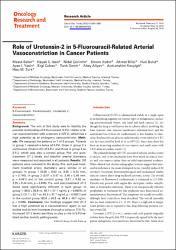| dc.contributor.author | Şeker, Mesut | |
| dc.contributor.author | İsen, Hayati Can | |
| dc.contributor.author | Çevirme, Nidal | |
| dc.contributor.author | Aydın, Sinem | |
| dc.contributor.author | Bilici, Ahmet | |
| dc.contributor.author | Bulut, Huri | |
| dc.contributor.author | Yasin, Ayşe İrem | |
| dc.contributor.author | Çoban, Ezgi | |
| dc.contributor.author | Demir, Tarık | |
| dc.contributor.author | Aliyev, Altay | |
| dc.contributor.author | Koçyiğit, Abdurrahim | |
| dc.contributor.author | Türk, Hacı Mehmet | |
| dc.date.accessioned | 10.07.201910:49:13 | |
| dc.date.accessioned | 2019-07-10T20:02:14Z | |
| dc.date.available | 10.07.201910:49:13 | |
| dc.date.available | 2019-07-10T20:02:14Z | |
| dc.date.issued | 2018 | en_US |
| dc.identifier.citation | Şeker, M., İsen, H. C., Çevirme, N., Aydın, S., Bilici, A., Bulut, H. ... Türk, H. M. (2018). Role of urotensin-2 in 5-fluorouracil-related arterial vasoconstriction in cancer patients. Journal of Oncology Research and Treatment, 41(9), 545-549. https://dx.doi.org/10.1159/000490120 | en_US |
| dc.identifier.issn | 2296-5270 | |
| dc.identifier.issn | 2296-5262 | |
| dc.identifier.uri | https://dx.doi.org/10.1159/000490120 | |
| dc.identifier.uri | https://hdl.handle.net/20.500.12511/3589 | |
| dc.description | WOS: 000444108500007 | en_US |
| dc.description | PubMed ID: 30121640 | en_US |
| dc.description.abstract | Background: The aim of this study was to identify the possible relationship of 5-fluorouracil (5-FU)-related arterial vasoconstriction with urotensin-2 (UT-2), which has a high potential as an endogenic vasoconstrictor. Methods: We assigned the patients to 1 of 3 groups. Patients in group 1 received a bolus of 5-FU, those in group2a continuous infusion (CI) of 5-FU, and those in group 3 no 5-FU, which was also a control group. Pre- and post-treatment UT-2 levels and brachial arterial diameters were measured and recorded in all patients. Results: 132 patients were included in the study. Pre-and post-treatment brachial artery diameters were similar in all groups: in group 1 (3.28 +/- 0.52 vs. 3.25 +/- 0.44 mm, p = 0.740), in group 2 (3.57 +/- 0.47 vs. 3.46 +/- 0.45 mm, p = 0.441) and in the control group (3.51 +/- 0.52 vs. 3.25 +/- 0.44 mm, p = 0.818). Pre-and post-treatment UT-2 levels were significantly different in each group: in group 1 (39.5 +/- 30.9 vs. 56.7 +/- 27.1 ng/ml, p = 0.0001), in group 2 (37.7 +/- 33.7 vs. 62.5 +/- 37.7 ng/ml, p = 0.0001) and in the control group (52.9 +/- 40.2 vs. 60.8 +/- 40.7 ng/ml, p = 0.006). Conclusion: Our findings suggest that UT-2 has a high potential as a vasoconstrictor agent in our bodies and its level increases through a bolus or CI 5-FU. Increased UT-2 levels are likely to play a role in 5-FU-related cardiac toxicity pathogenesis. | en_US |
| dc.language.iso | eng | en_US |
| dc.publisher | Karger | en_US |
| dc.rights | info:eu-repo/semantics/openAccess | en_US |
| dc.subject | 5-Fluorouracil | en_US |
| dc.subject | Cardiotoxicity | en_US |
| dc.subject | Urotensin 2 | en_US |
| dc.subject | Vasoconstriction | en_US |
| dc.title | Role of urotensin-2 in 5-fluorouracil-related arterial vasoconstriction in cancer patients | en_US |
| dc.type | article | en_US |
| dc.relation.ispartof | Oncology Research and Treatment | en_US |
| dc.department | İstanbul Medipol Üniversitesi, Tıp Fakültesi, Dahili Tıp Bilimleri Bölümü, İç Hastalıkları Ana Bilim Dalı | en_US |
| dc.identifier.volume | 41 | en_US |
| dc.identifier.issue | 9 | en_US |
| dc.identifier.startpage | 545 | en_US |
| dc.identifier.endpage | 549 | en_US |
| dc.relation.publicationcategory | Makale - Uluslararası Hakemli Dergi - Kurum Öğretim Elemanı | en_US |
| dc.identifier.doi | 10.1159/000490120 | en_US |
| dc.identifier.wosquality | Q4 | en_US |
| dc.identifier.scopusquality | Q3 | en_US |


















